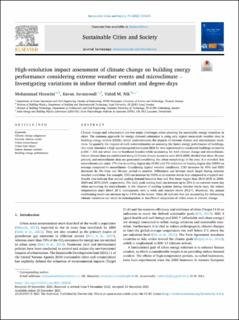| dc.contributor.author | Hosseini, Mohammad | |
| dc.contributor.author | Javanroodi, Kavan | |
| dc.contributor.author | Hosseini, Mohammad | |
| dc.contributor.author | Nik, Vahid M. | |
| dc.contributor.author | Javanroodi, Kavan | |
| dc.contributor.author | Javanroodi, Kavan | |
| dc.contributor.author | Nik, Vahid m. | |
| dc.contributor.author | Nik, Vahid m. | |
| dc.date.accessioned | 2023-03-31T08:01:32Z | |
| dc.date.available | 2023-03-31T08:01:32Z | |
| dc.date.created | 2022-04-11T09:52:20Z | |
| dc.date.issued | 2022 | |
| dc.identifier.citation | Sustainable Cities and Society (SCS). 2022, 78 . | en_US |
| dc.identifier.issn | 2210-6707 | |
| dc.identifier.uri | https://hdl.handle.net/11250/3061309 | |
| dc.description.abstract | Climate change and urbanization are two major challenges when planning for sustainable energy transition in cities. The common approach for energy demand estimation is using only typical meso-scale weather data in building energy models (BEMs), which underestimates the impacts of extreme climate and microclimate variations. To quantify the impacts of such underestimation on assessing the future energy performance of buildings, this study simulates a high spatiotemporal resolution BEM for two representative residential buildings located in a 600 × 600 m2 urban area in Southeast Sweden while accounting for both climate change and microclimate. Future climate data are synthesized using 13 future climate scenarios over 2010-2099, divided into three 30-year periods, and microclimate data are generated considering the urban morphology of the area. It is revealed that microclimate can cause 17% rise in cooling degree-day (CDD) and 7% reduction in heating degree-day (HDD) on average compared to mesoclimate. Considering typical weather conditions, CDD increases by 45% and HDD decreases by 8% from one 30-year period to another. Differences can become much larger during extreme weather conditions. For example, CDD can increase by 500% in an extreme warm July compared to a typical one. Results also indicate that annual cooling demand becomes four and five times bigger than 2010-2039 in 2040-2069 and 2070-2099, respectively. The daily peak cooling load can increase up to 25% in an extreme warm day when accounting for microclimate. In the absence of cooling systems during extreme warm days, the indoor temperature stays above 26°C continuously over a week and reaches above 29.2°C. Moreover, the annual overheating hours can increase up to 140% in the future. These all indicate that not accounting for influencing climate variations can result in maladaptation or insufficient adaptation of urban areas to climate change. | en_US |
| dc.language.iso | eng | en_US |
| dc.publisher | Elsevier | en_US |
| dc.relation.uri | https://doi.org/10.1016/j.scs.2021.103634 | |
| dc.rights | Navngivelse 4.0 Internasjonal | * |
| dc.rights.uri | http://creativecommons.org/licenses/by/4.0/deed.no | * |
| dc.title | High-resolution impact assessment of climate change on building energy performance considering extreme weather events and microclimate – Investigating variations in indoor thermal comfort and degree-days | en_US |
| dc.title.alternative | High-resolution impact assessment of climate change on building energy performance considering extreme weather events and microclimate – Investigating variations in indoor thermal comfort and degree-days | en_US |
| dc.type | Peer reviewed | en_US |
| dc.type | Journal article | en_US |
| dc.description.version | publishedVersion | en_US |
| dc.source.pagenumber | 21 | en_US |
| dc.source.volume | 78 | en_US |
| dc.source.journal | Sustainable Cities and Society (SCS) | en_US |
| dc.identifier.doi | 10.1016/j.scs.2021.103634 | |
| dc.identifier.cristin | 2016610 | |
| cristin.ispublished | true | |
| cristin.fulltext | original | |
| cristin.qualitycode | 1 | |

